 |
|

|
 |
TABLE of CONTENTS
 |
5% Efficiencies goal met: More than $67 million in savings identified |
By Shannon Fiecke, Research Services & Library
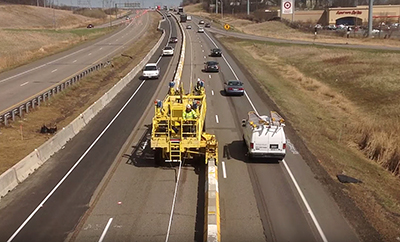
Movable barriers on Interstate 494 allow two lanes of traffic during peak periods, which reduced the amount of additional pavement needed for temporary staging, a cost savings of $750,000. This was one of hundreds of efficiencies documented in state road construction projects. Photo from MnDOT traffic camera |
Each day, MnDOT employees find ways to stretch taxpayer dollars and lower the cost of bridge and highway projects, but until recently the agency didn’t tally these efficiencies annually statewide.
For the past year, a cross-functional team examined dozens of major construction projects to document cost-saving decisions that were made during the design and development of the projects. These savings equal at least 5 percent of the state’s road construction budget, a charge set by the 2014 state legislature.
MnDOT surpassed that 5 percent threshold, identifying more than $67 million in savings statewide. Now the agency is working to identify which measures and best practices can be further expanded across the agency.
“Not only did we figure out how to better track the efficiencies that we have, but we are planning how to integrate the best practices we found going forward,” said Dan DuHamel, senior advisor and special projects director.
Val Svensson, Project Management and Technical Support, led the efficiencies team that analyzed construction projects with district teams to learn what critical decisions were made that led to cost savings. Her group also looked at missed opportunities and challenges, finding common themes that will be looked at as an agency.
“It was a major undertaking, but we had a lot of people, including our technical experts, come to the table to help us,” Svensson said. “That is the only reason we were able to accomplish this.”
The team analyzed all state road construction projects ($10 million-plus) let in FY 2015, as well as projects with significant procedural changes, for cost-saving design and construction decisions. These decisions included applying emerging pavement research from MnROAD to optimize pavement thickness, the staging of road closures and the width of road shoulders. The identified project-based efficiencies totaled more than $60 million.
Other documented agency efficiencies and maintenance and operations initiatives, such as the deployment of tow-plows and the installation of LED lights, produced an additional $7.5 million in savings.
Many more projects at MnDOT have cost savings, but only select projects were analyzed because of the time and research required to document the savings.
Major takeaways from the study include the value of effective project management and unhurried decision-making.
Chris Berrens, transportation planner, who was part of the efficiencies team, said “right-sizing” projects can save taxpayers millions of dollars. Project planners must wrestle with how to deliver less-expensive alternatives while not sacrificing performance.
“The deliberate decisions that are being made at MnDOT matter because delivering our transportation system costs so much,” Berrens said.
For more information, visit the EFE-Efficiencies page on iHUB.
|
 |
|

|
 |
TABLE of CONTENTS
 |
Rural intersection conflict warning systems go up around state |
|
This video explains how the rural intersection conflict warning system works. MnDOT is installing the system at 54 high-risk locations around the state. The system is used at stop-controlled intersections to alert drivers when vehicles are approaching the intersection. Video produced by Rich Kemp and Sue Roe |
|
 |
|

|
 |
TABLE of CONTENTS
 |
Changing light bulbs to save on energy costs |
|
By Micheal Foley, Research Services & Library
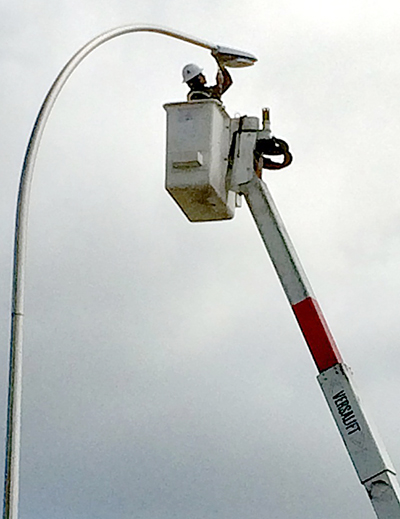
A River City Electric crew member replaces a light fixture with LED lighting along Hwy 52 in Rochester on Aug. 24. A total of 393 fixtures were replaced in Rochester. Photo by Mike Dougherty |
Many Minnesota households have found savings on their energy bills in recent years by switching from traditional incandescent light bulbs to compact fluorescents or light-emitting diodes. Now MnDOT is doing something similar to cut costs associated with running its growing system of roadway lights.
“Drivers will see whiter light, but the biggest impacts will be a reduction in the energy bill and not having to replace bulbs every four years,” said Michael Gerbensky, Metro District signal design and lighting management engineer. “This means having our maintenance personnel out on the roadway less often, which reduces our traffic control costs and also improves safety.”
Contractors recently replaced 393 high-pressure sodium light fixtures with more efficient and longer lasting LEDs along Hwy 52 in Rochester. Later this year, MnDOT will replace an additional 569 lights along I-35 between Elko and the Iowa border.
The projects are part of a bigger statewide plan to replace all of MnDOT’s approximately 28,200 HPSs with LEDs. Gerbensky said the main reason for the statewide switch is efficiency, and he noted that Xcel Energy and other electricity providers offer rebates for LED conversion.
“LEDs reduce the overall lifecycle cost, which frees up funding for other uses,” said Gerbensky.
To complete statewide conversion, some challenges will need to be overcome. It’s difficult to pinpoint exactly when the conversion will be complete.
“It depends on funding availability and technological advancements. Manufacturers are still working with us on approved products for tower and tunnel lighting,” Gerbensky said.
For example, MnDOT is still working with manufacturers to find luminaires that meet light level requirements for existing 100- to 140-foot mast luminaires. Tunnel lighting needs to be analyzed on a location-by-location basis to determine the cost-effectiveness of making the replacement based on energy savings, maintenance savings and the replacement cost.
Based on lifecycle costs, the LED lights that are being installed will save enough energy to pay for their installation within five years. After installation costs, MnDOT expects to save between $600,000 and $1.05 million in reduced electricity costs in 2015 alone. Going forward, the average annual savings will be $1.05 million to $1.45 million.
And the savings don’t just stop with electricity usage. LED lights last longer and require less maintenance than HPSs, so MnDOT estimates it will save at least an additional $500,000 per year in maintenance and re-lamping costs.
“To put it in perspective, the energy and re-lamping savings in the Metro District alone will exceed what we are currently allocated for lighting system replacement,” Gerbensky said. “The Metro District has already let several large projects that will convert more than 14,000 lights to LED by next fall.” |
 |
|

|
 |
TABLE of CONTENTS
 |
New bridge offers community chance to savor its past |
By Mike Dougherty, District 6 public affairs coordinator
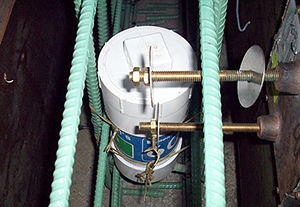
A time capsule was placed and secured in the rebar of a portion of the Hwy 60 Bridge in Mazeppa and was eventually covered with concrete. Photo courtesy of the Mazeppa Area Historical Society |
The small Wabasha County community of Mazeppa is proud of its history and they have an active group that promotes the town’s past.
So when they approached MnDOT this summer with the idea of placing a time capsule in one of the two bridges the agency was replacing that crosses the North Fork Zumbro River, MnDOT outlined what could work and when it would need the capsule.
The Mazeppa Area Historical Society obtained the specified container and worked with Duff Bement, District 6 construction inspector, who was on site for the project.
“They were good folks who wanted to do something with their history and we were able to make it work,” Bement said.
Members of the group selected newspapers, information pamphlets, two old cell phones, postcards and some flash drives containing pictures and videos from Mazeppa.
"I always enjoyed finding something from the past…so hopefully now the people who find this capsule will enjoy it," Tom Stahman, Mazeppa Historical Society's webmaster, told KTTC-TV in an interview about the capsule.
The capsule was just one activity that captured the community’s attention this summer. The bridge project was a big part of the community and they celebrated MnDOT’s efforts and its workers with the opening of the bridges Sept. 4.
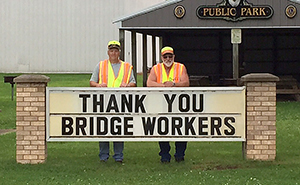
Craig Johnson, left, and Duff Bement, District 6, stand at a sign in Mazeppa that thanked the workers on the Hwy 60 Bridge project. Johnson is the project manager and Bement is the chief inspector. Photo by Mike Dougherty |
The key was how workers interacted with the community as the project progressed. There were questions and occasional complaints, but MnDOT and the contractor, ICON Constructors, worked to adjust when they could.
The project involved replacing two bridges, which book-end the primary route of Hwy 60 into Mazeppa, a community of 832 people about 20 miles northeast of Rochester. The detour was lengthy, but locals used other roads.
“We weren’t sure what to expect, but it turned out all right,” said Helen Reiland, the president of the historical society, who traded a Mazeppa bumper sticker with Bement for the bridge plaque that notes the date of the old bridge and its number. The plaque resides in the historical society now. |
 |
|

|
 |
TABLE of CONTENTS
 |
Donated vacation hours sought for Paul Sargent |
Paul Sargent, Support Services Section at Central Office, is eligible for the state vacation donation program.
Sargent, who has worked at MnDOT for 38 years, was diagnosed with a serious, life threatening medical condition. He is unable to work due to this condition and will be on leave for an unknown period of time.
Employees may donate up to 40 hours of vacation per fiscal year; however, donations in any amount will be helpful. Hours donated are not considered taxable income for the donor nor are they considered tax-deductible expenses.
To donate, please:
- Log into the State Employee Self-Service website
- Click on “Other Payroll.”
- Click on “Leave donations.”
- Click on “Input Your Leave Donations,”
- Click on the magnifying glass next to “Reserve Bank” to open a list of names.
- Choose the employee’s name you would like to donate to.
- Enter the number of hours that you wish to donate.
- Click on the yellow “Save” box.
The paper form is also available online to donate to an employee on the Vacation Donation Program. |
 |
|

|
 |
TABLE of CONTENTS
 |
Group establishes Doug Differt Endowed Scholarship Fund to promote engineering, sciences study |
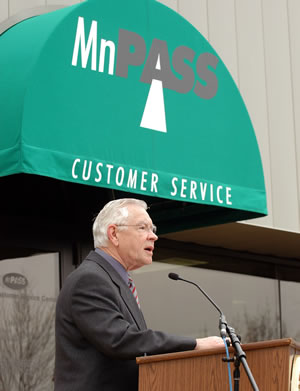
Deputy Commissioner Doug Differt provided a few remarks April 11, 2005, at the opening of the MnPASS Service Center in Golden Valley. Photo by David Gonzalez |
For more than 50 years, Doug Differt has helped keep Minnesota on the road to the future through his leadership and engineering work in both the public and private sectors.
Differt, who served as MnDOT’s deputy commissioner/chief engineer from 1986 to 1991 and from 2003 to 2006, is being honored for his contributions to transportation with the creation of an endowed scholarship in his name at Inver Hills Community College and Dakota County Technical College, according to Judy Jacobs, DCTC communications specialist.
The scholarship is intended to inspire and empower students attending Inver Hills and DCTC to pursue careers in science, technology, engineering and math by gaining the leadership and problem-solving skills to help their communities.
"Doug has been and continues to be a strong promoter and supporter of young professionals throughout the organization," said Sue Mulvihill, current MnDOT deputy commissioner and chief engineer. "He is a strong leader who looks out for the future of young people, the technical professions, and organizations like MnDOT."
Friends and colleagues of Differt are invited to attend an open house Thursday, Oct. 15, to celebrate his many accomplishments. The event will be held from 4:30 – 6:30 p.m. at the main office of the Hiway Federal Credit Union, 840 Westminster Street, St. Paul. For more information, visit the event website at www.tinyurl.com/DougDiffert.
The event is sponsored by the Doug Differt Difference Makers Steering Committee, whose membership includes Mulvihill and former MnDOT leaders, as well as representatives from the private sector.
Differt’s transportation career with MnDOT began in 1955 as a laborer on construction projects. His career with the department expanded to the engineering and managerial ranks following his completion of a bachelor’s degree in civil engineering in 1961 and graduate study in transportation at Yale University in 1965. Differt held various engineering and management posts until 1991, when he left state government for the private sector.
For more information about the Doug Differt Endowed Scholarship Fund contact Gail Morrison, Executive Director of Foundation and Community Relations, at gmorris@inverhills.edu or 651-450-3512.
|
 |
|

|
 |
TABLE of CONTENTS
 |
2015 great Minnesota get together was a door buster |
By Mary McFarland Brooks
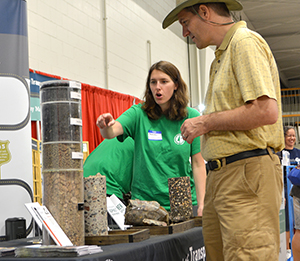
Sarah Jarman, Environmental Stewardship, disusses the concrete and asphalt display with a visitor at the MnDOT State Fair booth Sept. 4. Photo by Rich Kemp |
The 2015 State Fair started with a bang as 110,267 fairgoers propelled through the doors of the Education Building on opening day; a mighty crew compared to the 94,256 who showed up on opening day in 2014.
Of the 1.8 million total visitors to the 2015 fair, slightly behind 2014’s record breaking 1.82 million, thousands stopped by the MnDOT exhibit to learn about the need for transportation funding, how roadway concrete and asphalt degrade after use, and the progress of the St. Croix Crossing.
The booth educated visitors about the ways transportation affects and shapes their lives. More than 100 volunteers discussed current construction projects, handled visitors’ comments and requests ranging from light rail to roundabouts, and provided snowplow safety information.
MnDOT volunteers distributed more than 29,000 roadway maps and 2,600 bike maps. at the booth in the Education Building. Surprisingly, the roadway map distribution was greater than in 2014, with many visitors explaining they want the maps to use in addition to GPS, Google maps and other electronic sources.
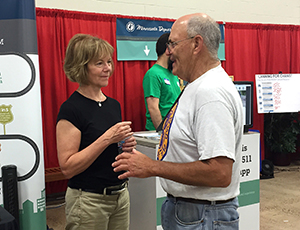
Lt. Gov. Tina Smith listened to a visitor at the MnDOT State Fair booth Sept. 3. Photo by Libby Schultz |
Lt. Gov. Tina Smith dropped by the booth and gave two thumbs up to the trivia wheel and outreach posters where public votes about transportation priorities were collected by MnDOT planners who staffed the area daily. Visitors to the booth weighed in on the Statewide Multimodal Transportation Plan and the Minnesota State Highway Investment Plan.
According to Katie Caskey, MnDOT planning program coordinator, “All in all, we engaged more than 5,000 people. The environment was the area that people felt the agency should focus on the most. Repairing and maintaining existing roads and bridges is the investment category people wanted funded.”
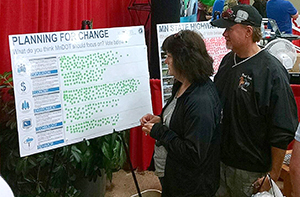
Visitors to the MnDOT State Fair booth used dots to vote for what they viewed as transportation funding priorities. Photo by Kevin Gutknecht |
As the planners illustrated this year, having access to fairgoers’ opinions as transportation funding is discussed informs the conversation from those most affected, the citizens of Minnesota.
MnDOT partnered with Metro Transit Metro, HOURCAR, Bike Walk Twin Cities, Nice Ride, Bicycle Alliance of Minnesota, local bike shops and organizations at the Kick Gas booth in the Eco Experience building, where more than 253,934 people visited. According to MnDOT’s bike and pedestrian section, which helped staff the booth, more than 7,000 bike maps were distributed.
“Thanks to the more than 100 employees who volunteered this year throughout the fair,” said Kevin Gutknecht, communications director. “Their generosity of time, energy and expertise contributed to MnDOT’s success. We appreciate their willingness to be part of the agency’s most visible public-participation event.”
Gutknecht also expressed his thanks to the Metro District crews who again, with their snowplows, were part of two of the fair’s daily parades. Banners attached to the plows encouraged fairgoers to visit the booth and many did just that.
The 2016 Minnesota State Fair will run from Aug. 25 through Sept. 5.
|
 |
|

|
 |
TABLE of CONTENTS
 |
When mishaps occur, Janelle Anderson handles tort claims |
By Sue Roe
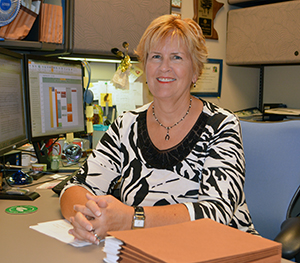
Janelle Anderson works to settle claims brought against MnDOT for such issues as potholes, bridge debris, snowplow damage and maintenance work area damage. Photo by Sue Roe |
When someone’s vehicle is damaged while passing through a maintenance work area or their mailbox is destroyed by a snowplow or a mower throws a rock that breaks their windshield, the Office of Traffic, Safety and Technology’s tort claims office works to settle the claims.
Janelle Anderson is the tort claims and traffic standards engineer. She and Jolene Servatius, tort claims specialist, handle uninsured tort claims and lawsuits against MnDOT.
Anderson has worked at MnDOT for 32 years in various positions including design engineer, materials engineer, pre-design/hydraulics engineer, and traffic engineer in District 4. She also worked in the Regional Transportation Management Center and was MnPASS operations manager. She has worked in tort claims for more than five years.
She earned her bachelor’s degree in civil engineering from the University of North Dakota and is a registered professional engineer.
What is a tort claim?
A tort is a civil wrong, other than a breach of contract, that a court of law will provide a monetary settlement, if found liable. Tort claims are not criminal wrongs, and they can be either intentional or unintentional (negligence).
At MnDOT, there are insured tort claims and uninsured tort claims. Insured claims involve a MnDOT vehicle that causes damage while doing work and are processed by the Department of Administration in conjunction with MnDOT’s insurance. My office handles uninsured tort claims and lawsuits.
What are your main job duties in the tort claims office?
We process claims that are filed including investigating, analyzing, and determining outcomes of the claims. We also work with the Attorney General’s Office to represent and defend MnDOT during discovery, depositions, mediation, litigation and other legal matters involving claims and lawsuits.
We train MnDOT personnel on reducing risk and liability in their jobs and we respond to data practices requests.
What kinds of uninsured tort claims does MnDOT get?
About 70 percent of all claims received are pothole claims. Other claims can be:
- Bridge debris (something falls off a bridge and damages a vehicle)
- Lighting (a light pole falls over and hits a car)
- Paint (someone gets paint on their car while passing a striping operation)
- Signal (a malfunctioning signal causes a crash)
- Sign (a sign was knocked over or improperly installed)
- Flooding (MnDOT reconstructs a road and changes the drainage and a farmer claims his cropland floods more now)
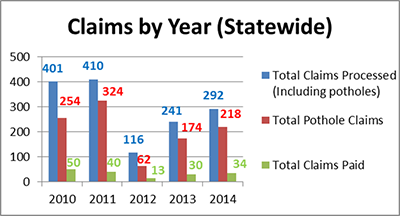
Graphic shows the number of pothole claims processed in a year compared to the total number of tort claims, and the amount of claims that were actually paid. |
How many claims has MnDOT had this year?
So far this year we have received more than 100 claims. At the same time last year we had more than 220 claims. In a good economy and good weather, we have fewer claims.
Where are tort claims paid from?
They are paid out of the Office of Legal Counsel. Large claims and lawsuits are paid out of a Minnesota Management and Budget fund, which comes from the trunk highway fund.
What do you enjoy most about your job?
I enjoy the people I work with and working on lawsuits. Working on lawsuits gives me a chance to use my engineering background to help the Attorney General’s office prepare MnDOT’s defense. I get to dig deep into how and why MnDOT did something and whether or not we were negligent. It’s also fun learning about the law and legal proceedings.
What is the most unusual claim or lawsuit your office has received?
Claim: Someone claimed their driveway was damaged after a MnDOT vehicle had a hydraulic fluid spill. The claimant drove through the spill, and when he got home the fluid dripped onto his new concrete driveway from his tires. He wanted MnDOT to tear out and replace his new concrete driveway. The claim was denied.
Lawsuit: Someone had a sewer backup into their basement and in the course of having the sewer lines repaired discovered that their pipe had been disconnected from the city sewer during construction of Interstate 35E (they lived atop the bluff). It had not been re-connected, so the sewage built up in the existing pipe for 30 or so years until it backed up into the claimant’s basement.
More information about torts claims is at www.mndot.gov/trafficeng/tortclaims/index.html.
Do you or a co-worker have an interesting job to share with readers? Click here to send us your ideas, and we’ll contact you for more information.
Recent employee profiles:
|
 |
|
| |
|



